Paper
Items Carried by Motor Car Operators
Do
you ever think about the days when motor cars were used on the
railroad to help get real work done? There were once thousands of
railroad workers who relied on motor cars to complete their daily
assignments. In this article I’d like to discuss paper items
that these men would have carried, many of which are available
today for us to collect. These items make interesting reading and
are very complimentary to your motor car. I will keep using words
such as "often", "many", "mostly"
and "some" rather than absolute terms because no two
railroads had exactly the same paperwork. So what did operators
carry? The two most important were a timetable and a book of
rules.
Employee
Timetables
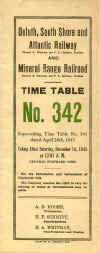 Most
railroad operations rely on trains that move on a schedule. At
one time, these schedules were well-documented in employee
timetables and a motor car operator would have been required to
carry one. These are quite different to the more widely known
public timetables. An employee timetable did not usually cover
the entire railroad. For smaller railroads it may have but larger
ones were divided up into division and subdivision timetables.
However, a timetable often covered several subdivisions or an
entire division. Updates were issued on a regular basis. The
superceded timetables were supposed to be destroyed but
thankfully for us, this did not always happen. When in use,
timetables were made to be folded into a handy size. About 4
inches wide and 10 inches high was a common standard.
Most
railroad operations rely on trains that move on a schedule. At
one time, these schedules were well-documented in employee
timetables and a motor car operator would have been required to
carry one. These are quite different to the more widely known
public timetables. An employee timetable did not usually cover
the entire railroad. For smaller railroads it may have but larger
ones were divided up into division and subdivision timetables.
However, a timetable often covered several subdivisions or an
entire division. Updates were issued on a regular basis. The
superceded timetables were supposed to be destroyed but
thankfully for us, this did not always happen. When in use,
timetables were made to be folded into a handy size. About 4
inches wide and 10 inches high was a common standard.
Employee
timetables contained a great deal of essential information. This
included listings of stations, distances between them, where the
sidings were and the capacity of each siding. For scheduled
trains it showed the direction, days of operation, class and
arrival/departure times at each station. Special rules in a
timetable included speed limits, block rules, locomotive ratings
and yard limits. Locations of train dispatchers telephone
numbers, official bulletin boards, special railroad grade
crossings, spring switches and overhead obstructions were
included. Even the names and locations of company doctors and
surgeons were listed.
If
you know the area where your motor car was used on the railroad
it came from, you can obtain an employee timetable for that
division or subdivision. If you know when your car was built and
when it’s service life ended, you can buy one from that time
period. That way you would have the same timetable used by the
operator of your particular car. So where can you get one? You
will see timetable sellers advertising in most railroad
magazines. You can also see timetables for sale at many of the
bigger railroad swap-meets. Lastly and most importantly for some
of us, online auction websites are a good source of timetables.
If you live in Florida and have a Western Pacific motor car,
seeing a WP timetable at your local swap-meet is unlikely but
finding one online at eBay (http://www.ebay.com) isn’t going
to be difficult. The drawback with online auction websites is
that you are bidding against others from across the country (or
even the world), so the price of a successful bid may not be seem
all that cheap. eBay seems to be the online auction site where
most employee and public timetables are sold. A check of how many
were being auctioned on December 9th showed a total of
402 timetables. There’s not much risk involved when buying
online - I’ve bought dozens of items on eBay and have
received every one, most of them very promptly. The online
auctions at Yahoo (http://www.yahoo.com) have timetables too.
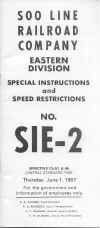 Common
employee timetables may sell online for a couple of bucks –
rarer and older ones may go for up to $50 or more. To take an
example, for my 1940 ex-DSS&A Fairmont M19 I bought on eBay a
1945 South Shore timetable. This covered the whole railroad
(Sault Ste Marie, MI and St. Ignace, MI to Marengo Junction, WI).
Since the DSS&A merged into the Soo Line in 1960, I also
bought a 1967 Soo Line timetable for the 8th and 9th
subdivisions of the Eastern Division. This particular timetable
covered most of the old South Shore. The former was $37 and the
latter was $10, both in very good condition. They could doubtless
have been gotten cheaper if I lived in Soo Line country!
Timetables for the largest roads like Santa Fe and Union Pacific
may sell online for as little as $2.
Common
employee timetables may sell online for a couple of bucks –
rarer and older ones may go for up to $50 or more. To take an
example, for my 1940 ex-DSS&A Fairmont M19 I bought on eBay a
1945 South Shore timetable. This covered the whole railroad
(Sault Ste Marie, MI and St. Ignace, MI to Marengo Junction, WI).
Since the DSS&A merged into the Soo Line in 1960, I also
bought a 1967 Soo Line timetable for the 8th and 9th
subdivisions of the Eastern Division. This particular timetable
covered most of the old South Shore. The former was $37 and the
latter was $10, both in very good condition. They could doubtless
have been gotten cheaper if I lived in Soo Line country!
Timetables for the largest roads like Santa Fe and Union Pacific
may sell online for as little as $2.
For
those for don’t know exactly where their car was used, some
employee timetables do cover the whole railroad. Additionally, by
the nineteen eighties many railroads were putting all their
timetables into one binder instead of issuing separate books.
Browse through one of these binders and see all the fascinating
places that your car could have been used at. This is what
happened to the Soo Line. An 80-page 1987 timetable included
every line on the whole railroad. It cost $4 on eBay.
Special
Instructions Books
For
railroads that preferred minimalist employee timetables, a
special instructions book accompanied them. This contained
information normally included in a more comprehensive timetable,
including that described in the section above. The advantage to
the railroad was the lower cost of printing general information
in just one place rather than printing it in every timetable. Per
instructions in that 1967 Soo Line Eastern Division Timetable,
"Employees must have a copy of the current Eastern Division
Special Instructions in their possession while on duty and be
governed thereby." I assume from this that motor car
operators would have carried such books.
Rule Books
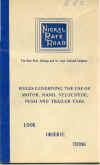 A
focus on safety was very important for motor car operators. In an
industrial environment filled with potential hazards, many of
them lethal, having a primary focus on safety was the only way to
reach retirement in one piece. One very important safety aid was
the rule book. Sometimes there was a separate rule book covering
motor car, hand car and velocipede operators. Note that the terms
‘track cars", "track motor cars" and
"motor cars" were all used in rule books. The New York
Central, Delaware & Hudson, Burlington Lines, Santa Fe,
Nickel Plate, Erie Lackawanna, C&O, B&O and Illinois
Central are railroads that did issue separate rule books. They
were usually 10-20 pages long. In addition to the rules, some
contained a list of questions about the rules, so that operators
could test themselves before a formal examination. Others
contained examples of completed forms that an operator would use
during performance of his assignment. Many contained a tear-out
page where the recipient of the book had to sign. He agreed to
comply with all the rules and his signature was witnessed. If he
then broke any rules, dismissal from the railroad could occur
very quickly.
A
focus on safety was very important for motor car operators. In an
industrial environment filled with potential hazards, many of
them lethal, having a primary focus on safety was the only way to
reach retirement in one piece. One very important safety aid was
the rule book. Sometimes there was a separate rule book covering
motor car, hand car and velocipede operators. Note that the terms
‘track cars", "track motor cars" and
"motor cars" were all used in rule books. The New York
Central, Delaware & Hudson, Burlington Lines, Santa Fe,
Nickel Plate, Erie Lackawanna, C&O, B&O and Illinois
Central are railroads that did issue separate rule books. They
were usually 10-20 pages long. In addition to the rules, some
contained a list of questions about the rules, so that operators
could test themselves before a formal examination. Others
contained examples of completed forms that an operator would use
during performance of his assignment. Many contained a tear-out
page where the recipient of the book had to sign. He agreed to
comply with all the rules and his signature was witnessed. If he
then broke any rules, dismissal from the railroad could occur
very quickly.
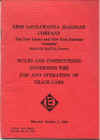 Rule
books for track car operators dealt with many subjects, including
authority to operate, daily inspection, filling gas tanks,
carrying tools and equipment, overloading, setting off, trailer
cars, crossings, frogs and switches, spacing and familiarity of
territory. Rule books usually contained speed limits for motor
cars. They always used a phrase similar to that in a 1966
Burlington Lines track car rule book: "In case of doubt or
uncertainty, the safe course must be taken". Rule books
required employees in charge of a car to carry a timetable and
many went so far as to require a standard watch which was
compared daily to a standard clock. The timetable or special
instructions book listed which locations had standard clocks.
Rule
books for track car operators dealt with many subjects, including
authority to operate, daily inspection, filling gas tanks,
carrying tools and equipment, overloading, setting off, trailer
cars, crossings, frogs and switches, spacing and familiarity of
territory. Rule books usually contained speed limits for motor
cars. They always used a phrase similar to that in a 1966
Burlington Lines track car rule book: "In case of doubt or
uncertainty, the safe course must be taken". Rule books
required employees in charge of a car to carry a timetable and
many went so far as to require a standard watch which was
compared daily to a standard clock. The timetable or special
instructions book listed which locations had standard clocks.
An
interesting example of a rule is this New York Central one from
1950: "Track cars while being operated must be kept at least
600 feet apart. Except in emergency, advance track car must not
be stopped until track car following has been signaled and signal
acknowledged". A 1968 B&O/C&O motor car rule book
contains the requirement: "A system number is assigned by
the Chief Engineer to each car by which it may be designated and
identified. This number must be displayed at all times, clean and
unobscured". This book also states "Application of
unapproved devices to a track car is prohibited".
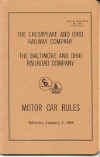 Rule
books usually required an operator to call the dispatcher for a
"line-up", which is a description is what is really
happening on the railroad in a given timeframe. This was
necessary to cover unscheduled train movements. However, the 1950
Delaware & Hudson track car rule book stated "When a
lineup of train movement is obtained it must not be considered
final because operating conditions may require running of
additional trains or change in lineup". When a line-up could
not be obtained, the 1952 C&O rule book stated "Movement
may be made without line-up, under such flag protection as may be
necessary, or extreme precaution exercised, and speed controlled
so that car can be stopped short of obstruction or removed from
track to prevent accident". As you can guess, there was many
an operator who had to hustle to get his motor car out of the way
of an approaching train or in the worst case, jump for his life!
Rule
books usually required an operator to call the dispatcher for a
"line-up", which is a description is what is really
happening on the railroad in a given timeframe. This was
necessary to cover unscheduled train movements. However, the 1950
Delaware & Hudson track car rule book stated "When a
lineup of train movement is obtained it must not be considered
final because operating conditions may require running of
additional trains or change in lineup". When a line-up could
not be obtained, the 1952 C&O rule book stated "Movement
may be made without line-up, under such flag protection as may be
necessary, or extreme precaution exercised, and speed controlled
so that car can be stopped short of obstruction or removed from
track to prevent accident". As you can guess, there was many
an operator who had to hustle to get his motor car out of the way
of an approaching train or in the worst case, jump for his life!
Motor
car operation rules on other railroads were included in a book of
safety rules that covered most or all employees. An example I
have is a 1956 Book of Safety Rules by Illinois Central that
contained 551 rules in total, 59 of which were relevant to track
car operators. The American Association of Railroads (AAR) also
published a book of safety rules containing a section for motor,
hand and push car operators.
Rule
books, like timetables, are advertised in magazines, seen at
swap-meets and are listed on eBay. A check on December 9th
showed a total of 212 railroad rule books advertised on eBay,
priced from $1 to $49.95. My experience is that track car rule
books sell on eBay for between five and ten dollars. An unusual
rule book that may become collectable in the future is the one
issued by MCCA, early editions of which are now ten years old.
We
should all take to heart the following advice from a 1964 Erie
Lackawanna Railroad rule book for track car use and operation:
"At any rate, follow the rules. Someone learned them the
hard way".
Other
Paperwork
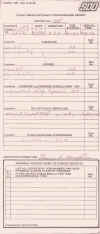 Two
other relevant pieces of paperwork were a timesheet and a daily
performance report. These could be two separate pieces of paper
or combined. A good example of a Soo Line daily performance
report is shown with this article. It is the summary of a
day’s work on November 11th 1984 in the Upper
Penninsula of Michigan, east of Gladstone. The track inspector
covered 26 miles on this day, including sidings at Swift and
Gould City. No defects were found. In 1984 the Soo Line still had
motor cars but this form doesn’t give us any clues about
whether a motor car or hyrail was used.
Two
other relevant pieces of paperwork were a timesheet and a daily
performance report. These could be two separate pieces of paper
or combined. A good example of a Soo Line daily performance
report is shown with this article. It is the summary of a
day’s work on November 11th 1984 in the Upper
Penninsula of Michigan, east of Gladstone. The track inspector
covered 26 miles on this day, including sidings at Swift and
Gould City. No defects were found. In 1984 the Soo Line still had
motor cars but this form doesn’t give us any clues about
whether a motor car or hyrail was used.
One
essential piece of paperwork carried by motor car operators that
is not usually considered a collectable is……..toilet
paper.
Other
Interesting Paper Items
One
fascinating railroad item is a track chart for the area or
division that your car came from. Here you can see the track
owned by the railroad, including all sidings, spurs and
junctions. If your chart is prior to 1980 you’ll be
marveling at how much is now gone. These track charts tend to be
more expensive than timetables and rule books but what an
excellent resource!
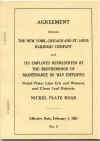 Books issued jointly by the railroad and the
union would have been of relevance to motor car operators. For
example, the contract between the union and the railroad spelled
out details that today would be contained in a corporate benefits
manual. An example of a 1951 Nickel Plate booklet containing such
is shown here. Striking a blow for equality, Rule 53 in this book
states: "The pay of female employees for the same class of
work shall be the same as that of men and their working
conditions must be healthful and fitted to their needs".
Rule 57 states: "The railroad will see that an adequate
supply of suitable water is made available to employees living in
its buildings and camp cars. Where it must be transported and
stored in receptacles, they shall be well adapted to their
purposes". Finally, many railroads issued regular magazines
for their workers, which detailed life in the company. Both of
these collectibles can be found for reasonable prices.
In
summary, you can add to the charm of your motor car by collecting
the paper items that would have been used by its operator. These
items also make very interesting reading. Buying them is not an
expensive proposition and the availability of so many of them
online makes it possible to find the specific ones that
compliment your car. I would like to thank Red Richardson for his
suggestions and Ron Zammit for his review
Books issued jointly by the railroad and the
union would have been of relevance to motor car operators. For
example, the contract between the union and the railroad spelled
out details that today would be contained in a corporate benefits
manual. An example of a 1951 Nickel Plate booklet containing such
is shown here. Striking a blow for equality, Rule 53 in this book
states: "The pay of female employees for the same class of
work shall be the same as that of men and their working
conditions must be healthful and fitted to their needs".
Rule 57 states: "The railroad will see that an adequate
supply of suitable water is made available to employees living in
its buildings and camp cars. Where it must be transported and
stored in receptacles, they shall be well adapted to their
purposes". Finally, many railroads issued regular magazines
for their workers, which detailed life in the company. Both of
these collectibles can be found for reasonable prices.
In
summary, you can add to the charm of your motor car by collecting
the paper items that would have been used by its operator. These
items also make very interesting reading. Buying them is not an
expensive proposition and the availability of so many of them
online makes it possible to find the specific ones that
compliment your car. I would like to thank Red Richardson for his
suggestions and Ron Zammit for his review
Return to Motor
Car Home Page
Last
Edited 28 January, 2018
 Most
railroad operations rely on trains that move on a schedule. At
one time, these schedules were well-documented in employee
timetables and a motor car operator would have been required to
carry one. These are quite different to the more widely known
public timetables. An employee timetable did not usually cover
the entire railroad. For smaller railroads it may have but larger
ones were divided up into division and subdivision timetables.
However, a timetable often covered several subdivisions or an
entire division. Updates were issued on a regular basis. The
superceded timetables were supposed to be destroyed but
thankfully for us, this did not always happen. When in use,
timetables were made to be folded into a handy size. About 4
inches wide and 10 inches high was a common standard.
Most
railroad operations rely on trains that move on a schedule. At
one time, these schedules were well-documented in employee
timetables and a motor car operator would have been required to
carry one. These are quite different to the more widely known
public timetables. An employee timetable did not usually cover
the entire railroad. For smaller railroads it may have but larger
ones were divided up into division and subdivision timetables.
However, a timetable often covered several subdivisions or an
entire division. Updates were issued on a regular basis. The
superceded timetables were supposed to be destroyed but
thankfully for us, this did not always happen. When in use,
timetables were made to be folded into a handy size. About 4
inches wide and 10 inches high was a common standard. 




 Books issued jointly by the railroad and the
union would have been of relevance to motor car operators. For
example, the contract between the union and the railroad spelled
out details that today would be contained in a corporate benefits
manual. An example of a 1951 Nickel Plate booklet containing such
is shown here. Striking a blow for equality, Rule 53 in this book
states: "The pay of female employees for the same class of
work shall be the same as that of men and their working
conditions must be healthful and fitted to their needs".
Rule 57 states: "The railroad will see that an adequate
supply of suitable water is made available to employees living in
its buildings and camp cars. Where it must be transported and
stored in receptacles, they shall be well adapted to their
purposes". Finally, many railroads issued regular magazines
for their workers, which detailed life in the company. Both of
these collectibles can be found for reasonable prices.
In
summary, you can add to the charm of your motor car by collecting
the paper items that would have been used by its operator. These
items also make very interesting reading. Buying them is not an
expensive proposition and the availability of so many of them
online makes it possible to find the specific ones that
compliment your car. I would like to thank Red Richardson for his
suggestions and Ron Zammit for his review
Books issued jointly by the railroad and the
union would have been of relevance to motor car operators. For
example, the contract between the union and the railroad spelled
out details that today would be contained in a corporate benefits
manual. An example of a 1951 Nickel Plate booklet containing such
is shown here. Striking a blow for equality, Rule 53 in this book
states: "The pay of female employees for the same class of
work shall be the same as that of men and their working
conditions must be healthful and fitted to their needs".
Rule 57 states: "The railroad will see that an adequate
supply of suitable water is made available to employees living in
its buildings and camp cars. Where it must be transported and
stored in receptacles, they shall be well adapted to their
purposes". Finally, many railroads issued regular magazines
for their workers, which detailed life in the company. Both of
these collectibles can be found for reasonable prices.
In
summary, you can add to the charm of your motor car by collecting
the paper items that would have been used by its operator. These
items also make very interesting reading. Buying them is not an
expensive proposition and the availability of so many of them
online makes it possible to find the specific ones that
compliment your car. I would like to thank Red Richardson for his
suggestions and Ron Zammit for his review